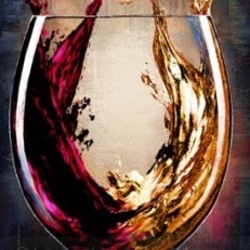Round Petal Wines
Giuseppe Rinaldi
Brunate - Le Coste Barolo Nebbiolo
2005 vintage. Seductive nose, much lighter body in color and in the mouth, acidity higher. Tons of rose petal and tar. Finish was only weak point - thought it was a bit too tannic and spicy — 10 years ago
Château Léoville-Las Cases
Grand Vin de Leoville du Marquis de las Cases Saint-Julien Red Bordeaux Blend 1997
Not the best year for Bordeaux's but this one continues to hold up well albeit a bit dirty....round structure easy to drink, but drink now, don't hold on to this vintage too much longer. — 10 years ago
Round Pond Estate
Rutherford Nebbiolo 2009
Great food wine. Wish I had more. — 10 years ago
Domaine François Raveneau
Montée de Tonnerre Chablis 1er Cru Chardonnay
Produttori del Barbaresco
Barbaresco Nebbiolo
Good anise, forest floor, spices to round out the dark fruit. Love the rose petal notes. Tannins are elegant but would love to taste this again in a few years. — 8 years ago
Domaine de la Romanée-Conti (DRC)
La Tâche Pinot Noir 1967
A gorgeous, soft rose petal nose. Delicate, deep, pretty with hints of orange blossom, tea and all kinds of resolved cherry fruit. Light, but beautifully deep. There’s a plush, haunting quality to this wine but it is light, translucent and ethereal. This is exquisite. — 8 years ago
La Rioja Alta
Gran Reserva 904 Rioja Tempranillo Graciano 2005
Started wth a slight must on the nose, but that blew off. Opened to round and bright red and some blue fruit. Tobacco and wood (not lavish oak, maybe cedar) round it out. Fine grained tannins and a wonderful finish. Love the value of Rioja and hard to believe I just got some of these babies recently. This was the 125th vintage. — 9 years ago
Château d'Yquem
Sauternes Sémillon-Sauvignon Blanc Blend 2010
Very young but lovely fresh apricots, peaches and pineapple. Honeysuckle and white flowers. What really makes this wine amazing though is the body. It's big and round the whole way through where so many Sauternes fall either in the middle or finish. Lovely. — 9 years ago
Château La Mission Haut-Brion
Pessac-Léognan Red Bordeaux Blend 1996
1996, This 1996 blend of 61% CS and 39% merlot, showed beautifully and justifying the 19 years of cellaring.
A truly deep rich and elegant wine. Lavish red appealing color, lovely nose, leather, black cherries, black current, wet soil, mineral, medium to full body, with soft round tannins, smooth, deep, complex, lovely acidity to balance, and a delicious finish, with hint of sweetness. A truly lovely wine. My score 91, drink to 2019. — 10 years ago
Château Léoville Barton
Saint-Julien Red Bordeaux Blend 2004
VINTAGE: 2004
BOTTLE: 375ml
APPEARANCE: Deep red, garnet meniscus, viscous legs.
NOSE: Allspice, white pepper, bell pepper, dark fruits.
MOUTHFEEL: Round, medium - acidity, medium + tannins.
PALATE: Cinnamon, tomato leaf, leather, hints of vanilla.
FINISH: Long with sandalwood throughout and some cocoa at the very end.
NOTES: Picked this up in December of 2017, thinking the 375 bottle will have made this ready to drink immediately. Was not wrong, it is drinking well, but there is sufficient backbone left in this wine to age for many more years to come, even in a 375. Nice layers of complexity that were fun to tease out, but still many notes that I don’t yet have the ability to properly identify. I look forward to trying again with more years under its belt. — 8 years ago
Château Cos d'Estournel
Saint-Estèphe Red Bordeaux Blend 1991
Is there any meal better than steak (Ribeye) and well aged Claret? This is another 1991 Bordeaux experiment of mine. 1991 was a vintage with horrible frosts and a less than favorable growing season, right? A vintage critically panned. This is my 3rd recent 91 from a good producer. And again, it didn’t disappoint. Like 97 and 07, it’s better with the right bottle age than young. Magic evolution happened in the bottle way down the road. This 91 is in great form with a fair amount of life ahead of it. On the nose; a little ripe fruit funk, wonderful dark & lighter red cassis, ripe blackberries, dark cherries, poached strawberries, plums, hues of blueberries, black raspberries, dry cranberries, vanilla, light cinnamon, rich, black turned earth, cedar, soft leather, dry stones, dry top soil, notes of dry herbs and fresh & dry red flowers. The body/palate is medium, round, ripe & still fresh. The tannins nearly completely resolved. Ripe, floral fruits of; blackberries, dark cherries, poached strawberries, plums, hues of blueberries, black raspberries, dry cranberries & half cooked rhubarb. Vanilla, light cinnamon, touch of clove & nutmeg, rich, black turned earth, cedar, soft leather, dry stones, dry crushed rocks, dry top soil, notes of dry herbs, a little band-aid and fresh & dry red flowers. The acidity drips over the palate and the long, well balanced, still structured, nice tension, good length finish lasts over a minute. Again, love & appreciate the 12.5% alcohol. What a beauty with and without the steak. Next time you’re in your fine wine retail shop and see a quality producers 91 that’s been well stored, buy it and have it with a Ribeye. Photos of; their exotic Estate, Chateau interior, newer barrel room and their vines as viewed from the front of the Chateau that are across the road. Producer notes and history...Cos d’Estournel has a long distinguished history in the St. Estephe. Louis Gaspard d’Estournel, gave his name to the estate after founding in 1811. It did not take long before Cos d’Estournel became famous with wine lovers and royalty all over the world. In those early days, Cos d’Estournel did not sell through Negociants. The owner preferred selling his wine directly to his customers. In fact, Cos d’Estournel was exported to numerous countries across the globe, with a large portion of the production being sold to India. It was that connection to India that inspired much of the unique, east Indian design we see at Cos d’Estournel today. Cos d’Estournel was one of the first Bordeaux Chateaux’s to bottle, label and sell their own wine. This practice continued until the death of Louis Gaspard d’Estournel in 1852. If you’re at the property, the statue on the bench in the front courtyard is of the founder, Louis Gaspard d’Estournel. The Estate was then purchased by an owner that sold their wines on the Place de Bordeaux using the negociant system. If the Chateau was not selling their wines through the negociant system, it would never have been included in the 1855 Classification. Imagine that! So, it turned out to be a fortuitous decision. Cos d’Estournel was sold to the Charmolue family owners of the neighboring Estate of Chateau Montrose. They continued to own the estate until 1917, when it was bought by Fernand Ginestet. This purchase was the beginning of the next major step in the development of Cos d’Estournel. Decades later, the grandchildren of Fernand Ginestet, Jean-Marie Prats, Yves Prats and Bruno Prats took over ownership and management of Cos d’Estournel. In 1995, Bruno Prats sold the property to the Merlaut family, owners of the Taillan Group. The next era in the development of Cos d’Estournel took place in 2000, when Cos d’Estournel was bought by the industrious and wealthy Michel Reybier, who earned his fortune in the food industry. Michel Reybier hired the son of Bruno Prats, Jean-Guillaume Prats to manage Cos d’Estournel. Things further improved with the efforts of Jean-Guillaume Prats who helped design the most modern wine making at that time. A complete renovation of Cos d’Estournel took place in not only the wine making facilities and cellars, but in parts of the Chateau as well. While the wine making facilities are completely modern with their 100% gravity design, the outward appearance retained the original design and feeling that has always been a part of Cos d’Estournel. On October 15, 2012, Jean Guillaume Prats announced he was leaving Cos d’Estournel to join LVMH (Pichon Baron). Jean Guillaume Prats was replaced by Aymeric de Gironde. Following the departure of Aymeric de Gironde in 2017, the owner, Michel Reybier took over managing the Estate. What makes the remodel special is that the cellars of Cos d’Estournel are entirely operated by gravity. There are no pumps of any kind to force the wine. The purpose is to allow a gentleness to the wine and improve its purity and allow for the expression of their terroir. It set a new benchmark for cellars not only in the Left Bank, but in all of Bordeaux. Perhaps, the most inventive part of the cellars is the four 100 hectoliter lift tanks or wine elevators that replace the pumps used in the traditional pumping over and the racking off processes, which introduce air and often destabilize the marc. From the moment the grapes arrive, everything travels by the flow of gravity. Jean Guillaume Prats called this process a “pumpless pump over.” The 91 hectare vineyard of Cos d’Estournel is planted to 65% Cabernet Sauvignon, 33% Merlot, 1% Cabernet Franc and 1% Petit Verdot. The vineyard is located extremely close to the border between Pauillac and Saint Estephe at the southern tip of the Saint Estephe. The Estate has very old Merlot vines as well, which date back more than 100 years. Part of the terroir is situated on the hill of Cos, which is at a high elevation for the Medoc at 20 meters. They also make a second wine called Pagodes de Cos. This is a great wine to buy in very good vintages. Especially, if your budget prohibits you from purchasing their first wine. — 8 years ago

Shafer Vineyards
Hillside Select Stags Leap District Cabernet Sauvignon 1995
The 1995 Shafer Hillside Select is still youthful, and would benefit from further another 10-20 years of cellaring. Saturating aromas of burnt brown sugar, toffee, cherry liqueur, blackberries, blueberries, graphite and dark chocolate round out the nose. In the mouth, its big and brawny, endowed with firm, ripe tannins, and vibrant acidity—that narrowly prevents a total plunge into velvety darkness. The intensity and concentration of fruit is over the top. A powerhouse from start to finish. 14.1% ABV — 11 years ago






















Matt Duncan
Lemon curd, a bit lactic but round with good weight. — 8 years ago